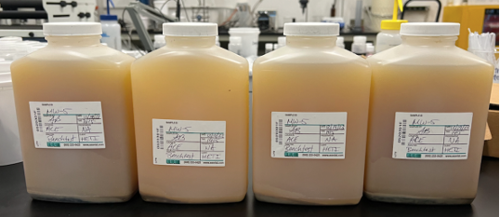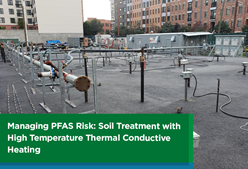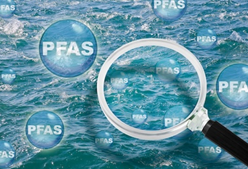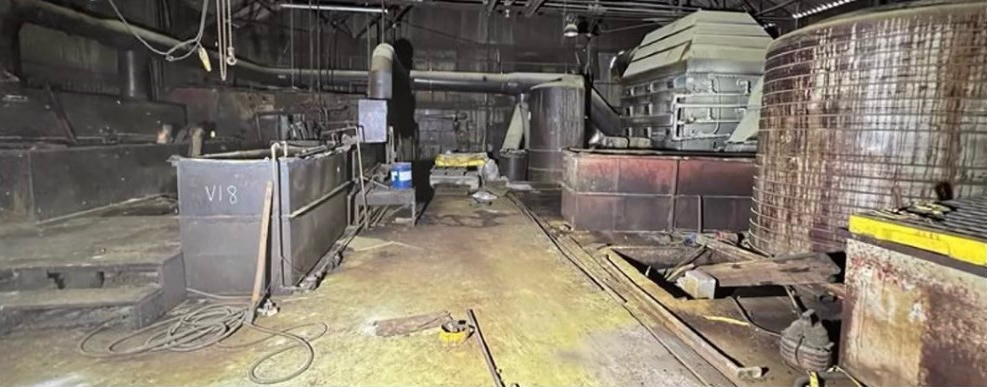Managing PFAS Risk: Plume Treatment with ColloidalChem™
In our previous blog post on managing PFAS risk, we explored the legal history and complex landscape of PFAS regulations. Responsible parties (RPs) who must meet strict new EPA PFAS regulations are seeking solutions to mitigate their PFAS risk and reduce their future liability. Helping them navigate the range of available PFAS remediation technologies to understand capabilities, advantages, and disadvantages is as important as learning about the new regulations. Building on that foundation, this post dives into Cascade’s ColloidalChem™ and ColloidalChem + Anchor ™, a cost-effective approach to mitigating risk stemming from PFAS contamination in groundwater.
What is ColloidalChem™?
Cascade’s ColloidalChem™ is a specialized form of activated carbon (AC) that can be utilized to remediate a range of groundwater contaminants including PFAS, chlorinated organic volatile compounds, solvents, and petroleum. Our colloidal carbon is engineered to have a very small particle size of 2-3 microns and a high surface area, which provides excellent contact for adsorbing PFAS and other contaminants. These ultra-fine particles are suspended in a liquid medium, enabling low pressure, controlled injection of ColloidalChem™ to optimize contact with PFAS. Cascade has developed an advanced method for PFAS – ColloidalChem + Anchor™, a patented injectable colloidal activated carbon with an integrated enzyme technology to control mobility in permeable reactive barrier (PRB) applications.
ColloidalChem + Anchor™ for PFAS Plume Treatment
In situ plume treatment can be accomplished using PRBs deployed across the flow path of contaminated groundwater. On sites with applicable groundwater conceptual site models (CSMs), PRBs are more sustainable than pump and treat systems, which have high O&M costs and the likelihood of indefinite operation to meet MCLs.
In contrast, PRBs act as an injectable filter that captures contaminants as the groundwater passes through. When ColloidalChem™ is injected in groundwater it is highly mobile, which is beneficial for distribution and contact with PFAS. However, if there is sufficient flow of the groundwater then the colloidal AC (with adsorbed PFAS) can exit the PRB and migrate downstream.
To overcome this challenge and immobilize the PRB, Cascade developed ColloidalChem + Anchor™, a patented enzyme-based approach which incorporates polysaccharide-stabilized AC colloids and cellulase enzymes in the injection mixture. The AC particles are highly mobile during injection, but in the days following the injection the enzymes degrade the colloid mobility chemistries, leaving the colloid particles in the location where they were injected within the confines of the PRB (see Figure 1). This “anchor” approach prevents AC particles from migrating to downgradient monitoring wells, which can interfere with performance monitoring or even require installation of new monitoring wells.
Other approaches to control colloidal carbon flows use divalent cations such as calcium with colloid stabilizers such as carboxymethyl cellulose. However, these react immediately within the mixing tank and the distribution within the PRB is compromised prior to injection.

Demonstrations of ColloidalChem™ Effectiveness
Since 2020, Cascade has been developing ColloidalChem™ to remediate PFAS in groundwater and has demonstrated PFAS reduction to the EPA’s new maximum contaminant levels (MCLs) during bench testing with groundwater samples contaminated with PFAS as well as lab-prepared PFAS samples.
In our most recent demonstration of PFAS-contaminated groundwater, field samples were analyzed and found to contain a combined total of 261 ppt of mixed PFAS compounds, including PFOA, PFHxA, PFHpA, PFNA, and PFDA. After treatment with ColloidalChem™ (1,000 mg/L concentration) all PFAS were below the detection limit of 2 ppt (Figure 2 and Table 1).


Cascade’s Integrated Technologies for Comprehensive PFAS Remediation
With 5,021 known PFAS contaminated locations in the US and another 41,828 industrial and municipal sites that are suspected sources of PFAS contamination, the remediation industry needs to deliver the most advanced, effective, and efficient solutions to tackle the PFAS problem in a meaningful timeframe. In most of these cases, the PFAS contamination initially impacted soil, and from there it leached into groundwater.
Fortunately, Cascade offers a suite of integrated technologies to deliver comprehensive PFAS remediation in groundwater and soil source zones. Besides ColloidalChem™ and ColloidalChem + Anchor™, we offer three additional technologies that make our integrated PFAS solutions the most robust, cost effective, and efficient approach in the remediation industry:
- WaterlooAPS – A premier high-resolution site characterization (HRSC) tool for measuring hydrostratigraphic data while also collecting multiple groundwater samples without cross-contamination on a single direct push rig advancement. To design an effective and best-cost PRB, it is important to perform a high-resolution design optimization (HRDO) utilizing reliable flux measurements to identify the transmissive and storage zones and determine the optimal target intervals for installing the PRB.
- Pathfinder – A fully-automated injection system designed to deliver colloidal solids like ColloidalChem + Anchor™ directly to the transmissive zones for optimal contact with PFAS. Pathfinder addresses the issue of uniform distribution by providing an automated system that maintains constant pressure and flow so that colloidal solids and liquids can be distributed evenly without exceeding the fracture pressure or the site’s hydraulic capacity. This system can achieve injection performance at up to 10 simultaneous locations and up to a total flow of 100 gpm or as low as 1 gpm at one location, with direct push or injection wells.
- TerraTherm™ – Our suite of high temperature thermal conduction heating (TCH) technologies can be deployed in situ or ex situ to remediate PFAS-contaminated soils. This approach heats PFAS-contaminated soils to 400°C to completely mineralize the PFAS. The fluorine produced reacts with naturally occurring metals such as calcium in the soil to form inert and non-toxic compounds.
By combining this integrated suite of remediation technologies to tackle PFAS in groundwater and source zone soils, Cascade comprehensively covers all the bases for your clients, helping them mitigate their PFAS risk and limit their future liability (Figure 3).

Managing PFAS Risk – Cascade is Here to Help
Clients with PFAS risk are facing potentially enormous liabilities and need the technical support of trusted environmental remediation providers. As the national leader in groundwater and soil remediation, Cascade offers an integrated suite of PFAS remediation solutions, to support clients across project phases from drilling and characterization through field implementation. Our technical experts and experienced field crews are here to help you manage risks and limit liability today and in the future for persistent PFAS chemicals and other contaminants.
Contact us today to get solutions for your PFAS risk and remediation needs. You can also learn more about our solutions from the webinars and resources below. And stay tuned for the third blog post in this series, Managing PFAS Risk: Source Zone Treatment with TerraThem™, available on 5/28/24. (Note, if you missed the first blog post in this PFAS series, you can find it here: EPA PFAS Regulations: Managing Risk, Limiting Liability.







